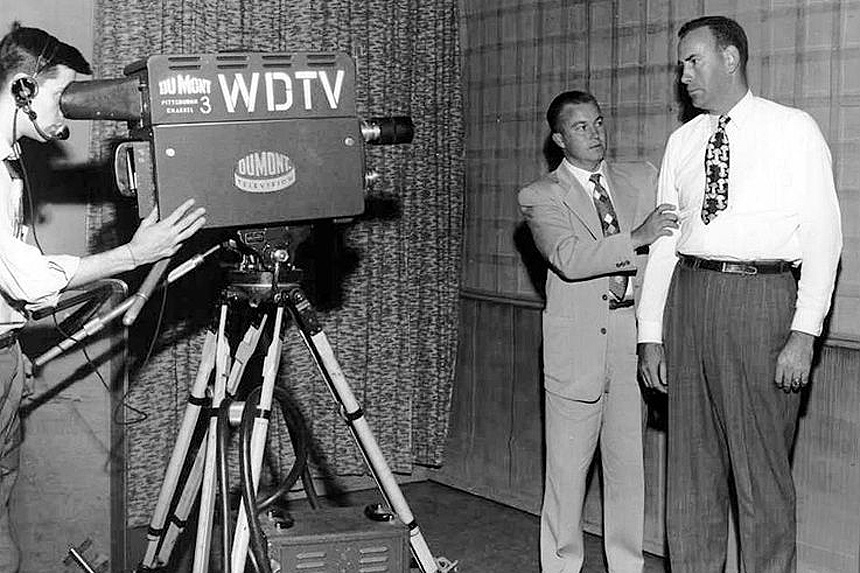Pittsburgh’s KDKA-TV made the first networked TV broadcast 70 years ago last month. We took a look back at that event, explaining how the new technology of the time made networks possible, and how one live broadcast came to be carried on 13 other stations. But that’s only part of the story. Those early attempts soon gave way to the rise of four major networks: NBC, CBS, ABC, and . . . DuMont? Here’s how four networks came together, and why one didn’t make it.
NBC
The oldest of the major broadcast networks in the United States, the National Broadcasting Company was founded in 1926 by the Radio Corporation of America, whose parent company was General Electric. The build-up to this moment had taken several years, as RCA had experimented with having different stations broadcasting shared programs at the same time. By 1926, they had purchased New York City radio station WEAF from AT&T, acquired New Jersey station WJZ (and moved it to NYC), and gotten station WRC started in Washington, D.C.
On January 1st, 1927, NBC made the bold move of splitting their radio stations into two distinct broadcasting strategies. The “Red Network,” built on the back of WEAF, would run music and entertainment (sponsored commercially); the “Blue Network,” starting with WJZ, would run unsponsored content, like news or culture programs. By April of that year, NBC launched two more networks of radio stations; the Orange, or Pacific Coast Network, ran Red programs on the West Coast. The Gold (or Pacific Gold) network offered Blue’s slate. By 1930, due to anti-trust concerns, General Electric had to split off RCA. RCA moved into new offices at Rockefeller Center in New York City.
The Orange radio network was officially absorbed by the Red in 1936; likewise, the Blue integrated the Gold network stations and programs into its vertical. This move came during a period of heavy government interest in how the networks were being run. A 1934 lawsuit by the Mutual Radio Network alleged that it was incredibly difficult for new radio stations and networks to be founded in an environment dominated by NBC and CBS. After a lengthy investigation, the FCC ordered RCA to sell off either the Red or Blue radio networks. Several years of legal entanglements and appeals followed, but the end only came when RCA sold the Blue network to the newly founded American Broadcasting System in 1942. The Red network was renamed NBC. NBC began moving in television in the late 1940s; by the end of 1950, the company owned and operated TV stations in seven major cities, including NYC and Los Angeles.
Among the first breakout hits for NBC was Texaco Star Theatre, a television version of a popular radio variety show. The program was intended to have a rotating casts of guest-hosts, but inaugural host, the comedian Milton Berle, proved so popular that he became the permanent host a few months later. Berle is regarded as the first major TV star, even earning the nickname “Mr. Television.”
ABC
The American Broadcasting Company became the new name for the Blue Network in 1943. ABC innovated the use of pre-taped radio programming at a time when the other networks relied heavily on live shows. This practice proved popular to big stars, like Bing Crosby, who enjoyed the freedom of taping ahead of time instead of being pinned to a particular time on a regular basis. ABC started applying for TV station licenses in 1947 and went on the air in 1948. WFIL-TV in Philadelphia was a major early affiliate; in 1950, that location would produce a smash hit with its show Bandstand, which was later renamed American Bandstand (the later Barry Manilow-penned theme song would reference Philadelphia in the lyrics).
Bandstand is still regarded as one of the most important shows in TV history. Running 37 seasons, 31 of which were hosted by Dick Clark, the show had an immeasurable impact on youth culture and inspired shows like Soul Train and, more recently, So You Think You Can Dance (which had been intended to be a segment on a proposed Bandstand revival). Among the acts that made their first national TV appearance on the show were The Jackson 5, Sonny and Cher, and Prince, while acts like Madonna, Stevie Wonder, and many more experienced career boosts from their early appearances.
CBS
Columbia Broadcasting System first took the air in 1929. It was founded by William S. Paley, who bought the 16 radio stations of United Independent Broadcasters and reorganized them under the new name. Paley had a number of dynamic approaches to getting his affiliate stations involved with the network. Whereas the NBC networks charged their affiliates for unsponsored radio programs, Paley decided to give his affiliate stations those shows for free so long as the stations ran every other sponsored show that CBS offered.
Paley was also considered a genius in terms of identifying, attracting, and managing talent. Among the giants that he drew to the network were George Burns, Gracie Allen, Jack Benny, and Kate Smith. Paley also pioneered the idea of setting early afternoons as time for soap opera programming, building a core of reliable, sponsored shows the pulled in regular, dedicated audiences. He also came up with the idea of putting together a separate news division and worked hard to sell CBS as a more culturally aware, intellectual operation. This led to the nickname “The Tiffany Network,” due to the idea that Paley cultivated prestige news and entertainment programming.
CBS was a bit slower to move into TV, but they smartly shifted familiar shows from radio to the new format, allowing for a continuity of audience. Examples include The Guiding Light, which switched in 1952, and Our Miss Brooks; big radio stars like Benny, Burns, and Allen would also successfully transition to CBS television. The network ran original programming on the radio until 1962, but it had been clear for some time that it had been officially replaced by TV as America’s medium of choice.
The Guiding Light proved to be an important piece of the CBS line-up, providing a foundation for a venerable block of soap opera programming that still continues today. Light itself ran for an incredible 57 years before folding in 2009. In January, we covered how CBS’s soap legacy came to be, and how it managed to stick around for so long.
DuMont Television Network
Did you expect the fourth network to be Fox? You may be shocked to learn that Fox didn’t exist as a TV broadcast entity until 1986. DuMont launched in 1946. It’s fair to say that DuMont was grown in a lab, as the company was founded out of Dr. Allen B. DuMont’s DuMont Laboratories.
The Laboratories started in DuMont’s basement and focused heavily on the technical side of TV. They were creating receivers by 1938 and figured out how to make cathode ray tubes last for 1000 hours, a 976-hour increase over their original life span. This new tube made consumer TV sets a practical reality. DuMont also made millions during World War II working on radar for the U.S. armed forces.
DuMont’s interest in television extended to his launch of TV station W3XWT in Washington, D.C. in 1945; this was backed in part by Paramount Pictures, which was a major shareholder in DuMont Laboratories. Though the network started slowly and they had no pre-existing radio network to draw on for shows or talent, DuMont had a number of ideas that adapted well to TV. They would run shows from Broadway. They were the first network to broadcast a feature film (Talk Fast, Mister), and also the first network with a regular situation comedy (Mary Kay and Johnny). DuMont can also claim the first televised soap opera, (Faraway Hill, which innovated the “Continued Next Week” end-title card) and the first science fiction show, Captain Video and His Video Rangers. The network also broke ground with the first shows featuring minority leads: The Gallery of Madame Liu-Tsong, starring Anna May Wong, and The Hazel Scott Show, a music program hosted by Trinidadian-born performer Hazel Scott, the first black person with an American TV show.
Unfortunately, even with a portfolio of groundbreaking shows, DuMont struggled. A combination of intense competition, a lack of resources that other networks had from diverse interests in radio, and ever-shifting FCC regulations hurt the company’s cash flow. Some concerns were incredibly political, such as the fact that AT&T would only allow DuMont to broadcast 37 weekly hours of prime time content along their coaxial lines, whereas they allowed NBC and CBS 100 hours each per week. Other concerns had to do with the machinations of Paramount; the company eventually took over DuMont completely, even though it had a complex web of relationships with the other networks, notably ABC. By 1956, the network had been shut down completely.
From the 1950s until the 1980s, the so-called “Big Three” dominated American television. The advent of HBO in the 1970s, the proliferation of cable stations in the early 1980s, and the arrival of the Fox Television Network in 1986 altered the landscape. Two more networks, The WB and UPN, came up in the 1990s, but eventually merged to form The CW, which remains on air today. The five broadcast networks still manage to survive, and even thrive, in a crowded content space that includes direct competition from an ever-increasing number of streaming outlets.
However, even that game continues to change. In 2014, CBS announced CBS All Access; it was the first subscription streaming service mobilized by an American broadcast network. With shows like Star Trek: Discovery and upcoming programs like Jordan Peele’s Twilight Zone reboot appearing first on CBS All Access, and word that the other networks may be developing their own platforms, the future of the networks isn’t entirely clear. Even if we aren’t sure where TV is going, history has proven that the American public will, without a doubt, be watching.
Featured image credit: DuMont’s program We, the People broadcasting live in 1952. (Photo by Judd Sheppard; Wikimedia Commons)
Become a Saturday Evening Post member and enjoy unlimited access. Subscribe now



